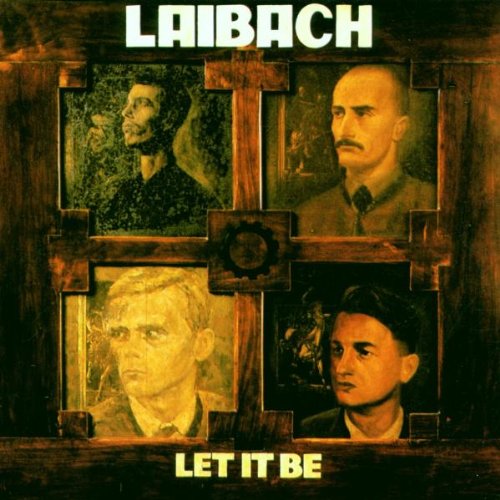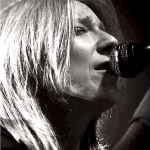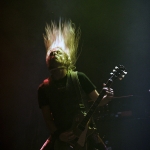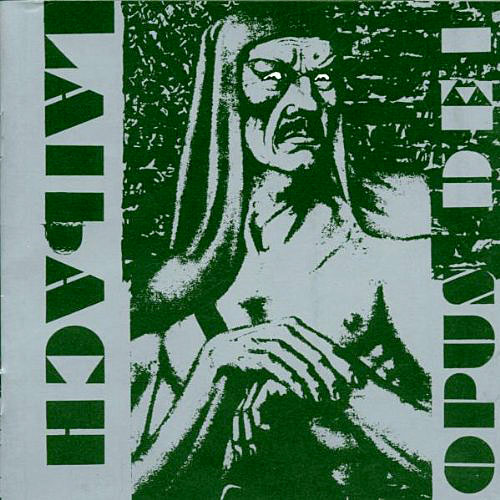The Laibach Story So Far…
1985 – 1990
April 1985 saw the release of the first Laibach album on the Slovenian Ropot (“Noise”) label. The ban on the use of their name meant that the record sleeve only carried an image of their now distinctive black cross symbol but it was to be the first of many albums they would release on a variety of labels around the world. This debut presented Laibach’s characteristic blend of Wagnerian horns, militaristic beats, atonal orchestral elements, samples of patriotic Tito speeches, and the severe tones of the group’s front man.
Their songs were rich in sly irony but were delivered with the straightest of faces. The next LP “Rekapitulacija 1980-1984” (1985) released on Hamburg independent label Walter Ulbricht Schallfolien was the first Laibach album to gain an international release (18) with “Nova Akropola” (1986) following on UK independent label Cherry Red. The band then commenced their first UK tour, bemusing audiences by using antlers, flags, and a man chopping wood on their stage, but Mute Records soon recognized Laibach’s striking uniqueness and signed them, releasing “Opus Dei” in 1987. Once again this album showcased the band’s considerable wit and humour, which this time were directed towards the subversion of contemporary rock music by transforming it into anthemic industrial hymns. “Opus Dei” contains their grandiose covers of Queen’s “One Vision” and Euro sing-a-long hit “Live is Life,” presented in both German and English versions.
Still wilfully courting controversy, Laibach were not afraid of hijacking and subverting Nazi imagery either. Their videos were skilful parodies of Nazi propaganda films like Triumph of the Will but a reproduction of a swastika made of axes on the LP’s inner sleeve caused outrage in some more “politically correct” circles until the more astute pointed out that the symbol had actually been taken from the anti-Nazi art of John Heartfield. They were sued by the militant Catholic organisation Opus Dei for the use of their name, but they successfully avoided court. The album is included in the authoritative collection “1001 Albums You Must Hear Before You Die” (2005, Cassell Illustrated, Quintet Publishing Limited). The group spent much of 1987 performing and spreading their messages, providing music for a performance by acclaimed British dancer Michael Clark as well as creating music for a Deutsches Schauspielhaus production of Macbeth. Refused entry into the USA on the grounds that they might be radical Communists, Laibach performed instead their first legal Slovenian concert since their 1983 ban.
The concert in Ljubljana’s Festival Hall was very successful and scenes from it can be seen in Goran Gajic’s 1987 film on Laibach, Victory under the Sun.
The year 1988 saw a continuation of Laibach’s playful usage of rock mythology when they released twin EPs containing eight different cover versions of The Rolling Stones’ “Sympathy for the Devil”. Besides Laibach’s normal triumphalist style, the song was presented in uncanny disco, rock, and primitive dance music versions. They followed it with their wry parody of the Beatles final LP “Let It Be” (1988). Laibach made the whole record as a song for song cover of the original, (except the title track) transforming each song into melodramatic Wagnerian epics at odds with the banal lyrics. By re-moulding The Beatles’ least successful LP in their own image, they were essentially paralleling the disintegration of pop’s utopian dream with the accelerating disintegration of Tito’s dream of a unified multi-cultural Yugoslavia. They were also interrogating pop music’s cherished ideal of originality. Laibach’s cover versions challenged the meaning of copyright in the age of computerized reproduction, pop music for Laibach being typified by its history of repetition and copying. On “Let It Be”, “Maggie Mae” was entirely replaced by absurdly militant versions of two German folk songs, while “Across the Universe” featured an angelic female choir accompanied by a harpsichord. The overall affect was darkly comedic, although Laibach’s arrangements were often very beautiful, too.

The year 1989 saw Laibach finally being allowed to tour the USA on a 16-date schedule. It was followed by a tour of Yugoslavia that even took them to Belgrade where they had not performed since Slobodan Miloševic came to power in 1987. The two concerts in Belgrade were extremely provocative. Before the Belgrade shows Laibach projected a World War Two German propaganda film on the bombing of Belgrade accompanied by extracts from agitational speeches by Miloševic. Immediately before Laibach played, the group’s collaborator Peter Mlakar of the NSK Department of Pure and Applied Philosophy dramatically addressed the Serb audience, warning them of war and disaster to come. During that period, Slovenia was openly moving towards becoming an independent democratic state and was antagonizing Serbia, which responded with an economic boycott of the Slovene republic. Laibach made the risky decision to play two concerts in this centre of Serbian nationalism amid strong (and ironic) suspicions that the Slovenian authorities had sponsored them, a rumour that persisted due to Laibach’s militant expression of Slovene identity, symbols and imagery including the architect Jože Plecnik’s unbuilt design for a Slovene parliament. The group then completed a wider European tour before returning to record a full studio version of their 1987 soundtrack with Hamburg’s Deutsches Schauspielhaus production of Macbeth (1989).
In December 1990 Laibach staged a concert at the thermoelectric power station in Trbovlje, their first appearance in their hometown since their initial banned project from 1980. The fact that the concert marked their tenth anniversary was significant in itself, but equally momentously it came in the light of the massive “yes” vote in the referendum on Slovene independence. Laibach made a typically ambivalent statement by using the title “10 Years of Laibach – 10 Years of Slovene Independence.” The show was opened by the local brass band, playing military marches. The event was held in a big, old, unheated industrial hall, at minus 15 Celsius and the group played the whole show bare-chested. Audience was served with hot tea and local spirits. The sound was so loud that pieces of ceiling were falling down. Sixteen years later British music magazine Wire proclaimed this show as one of the “60 most powerful concerts of all times”.
|
|

|

Black Stone Cherry |
LATEST GALLERY IMAGES

Elliot Minor 
Charity Workers Massacred |
|
|



